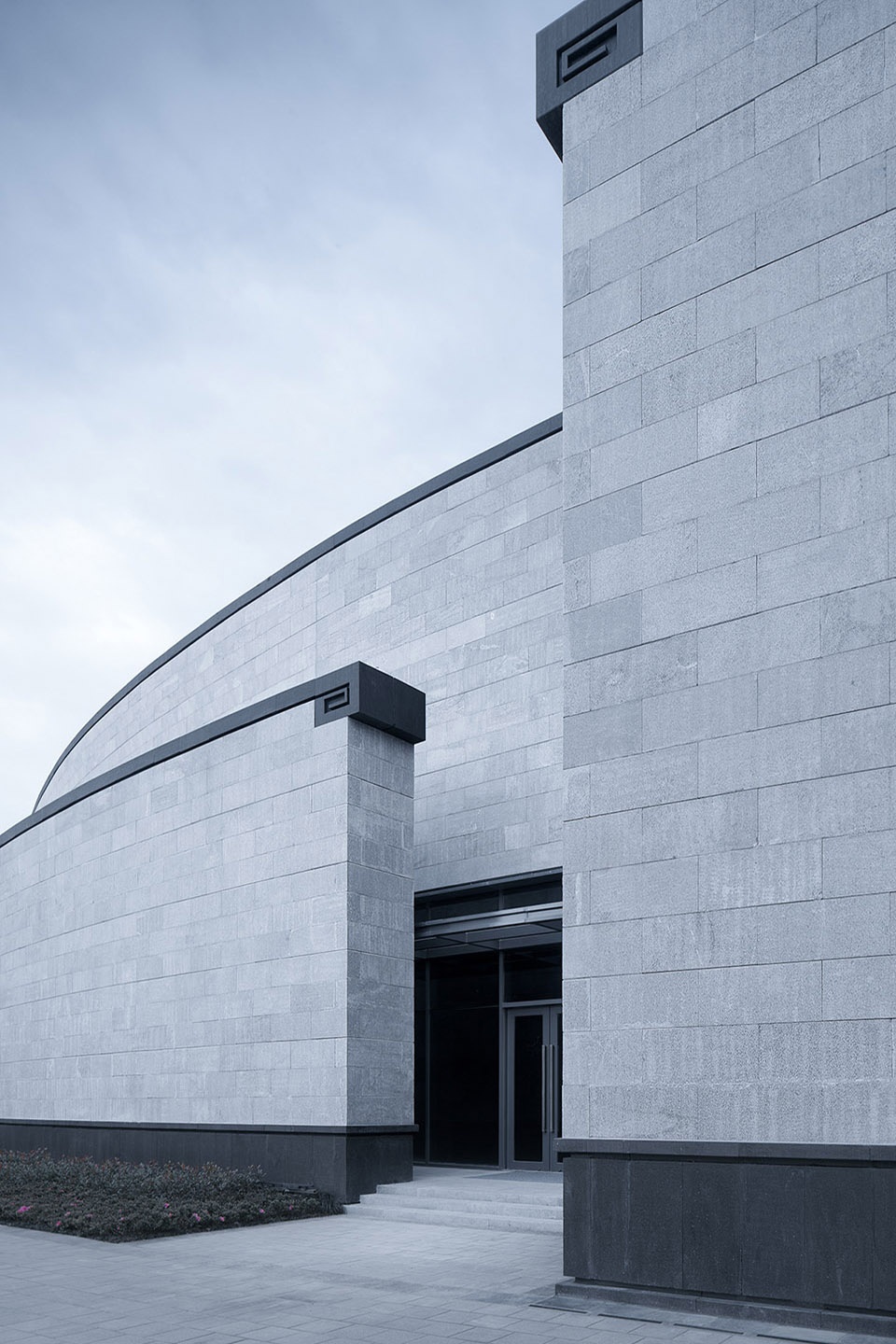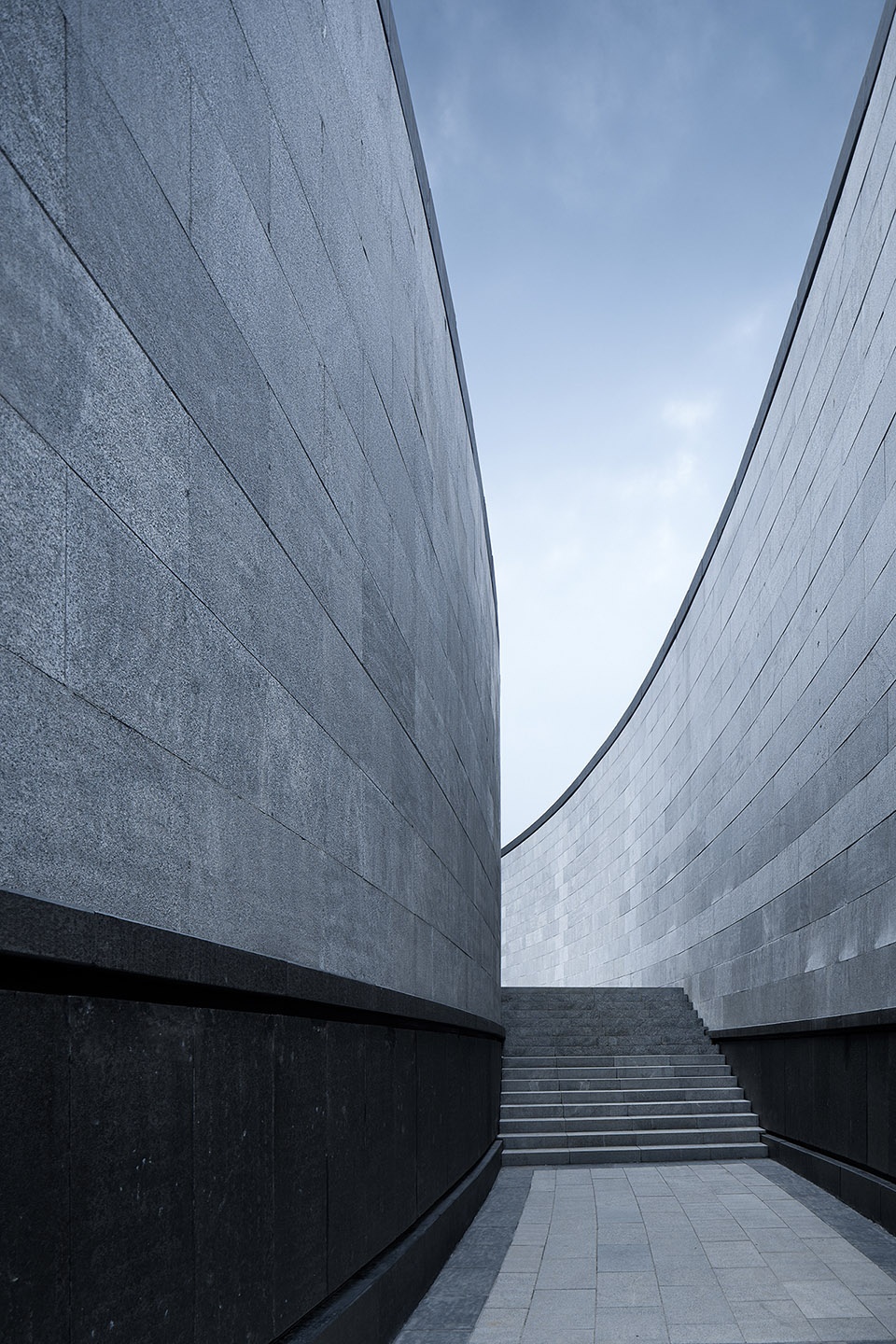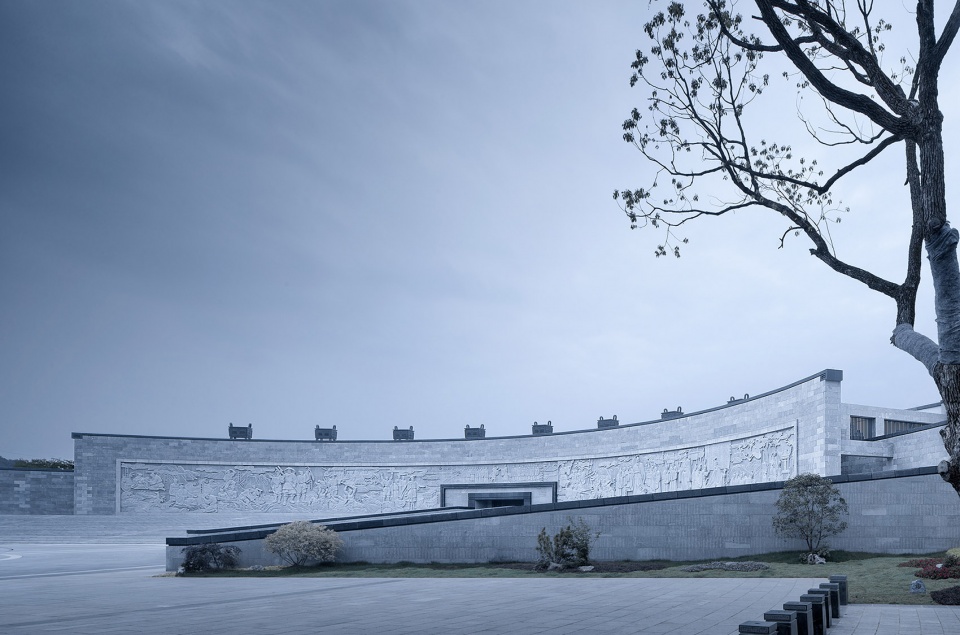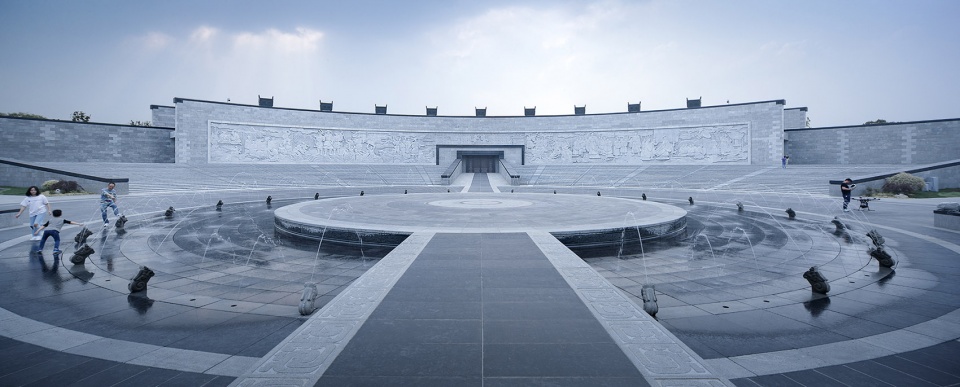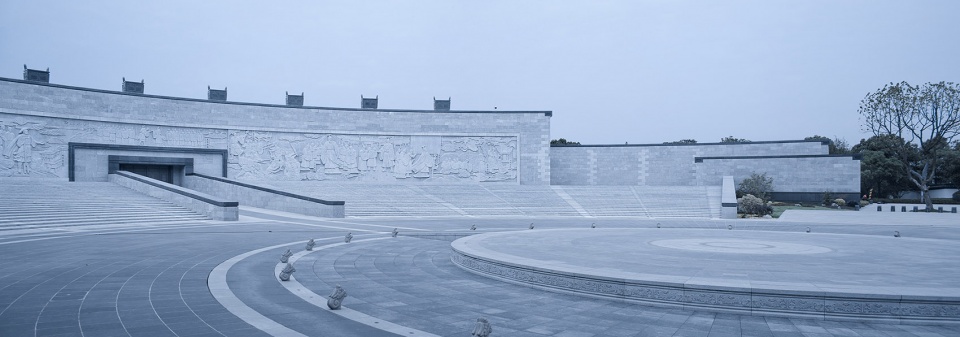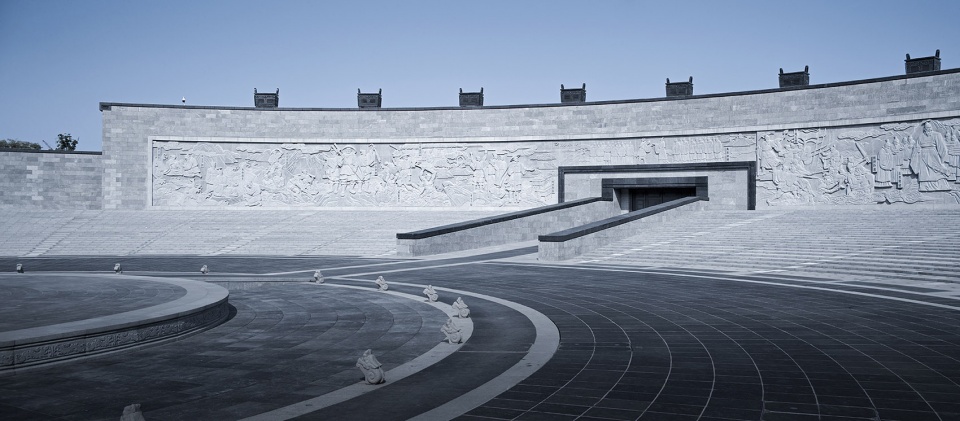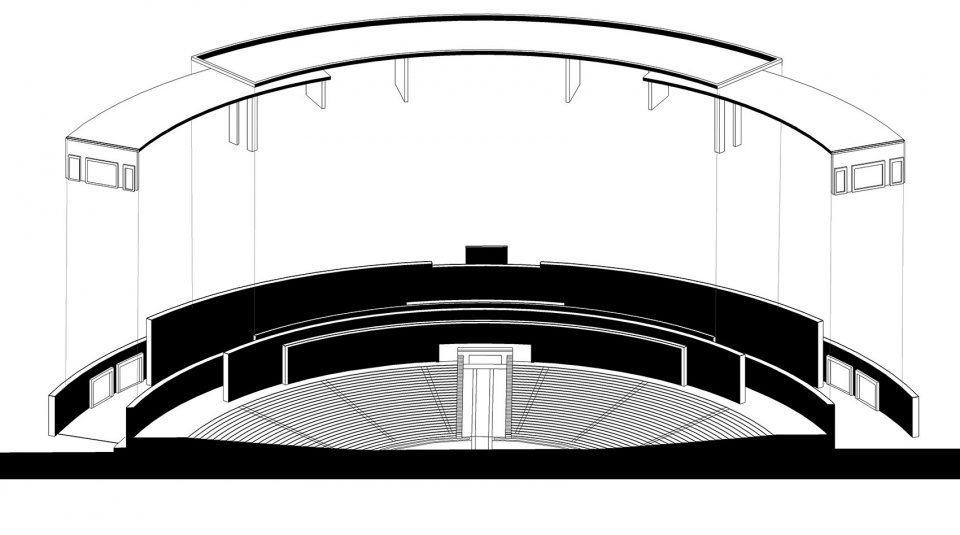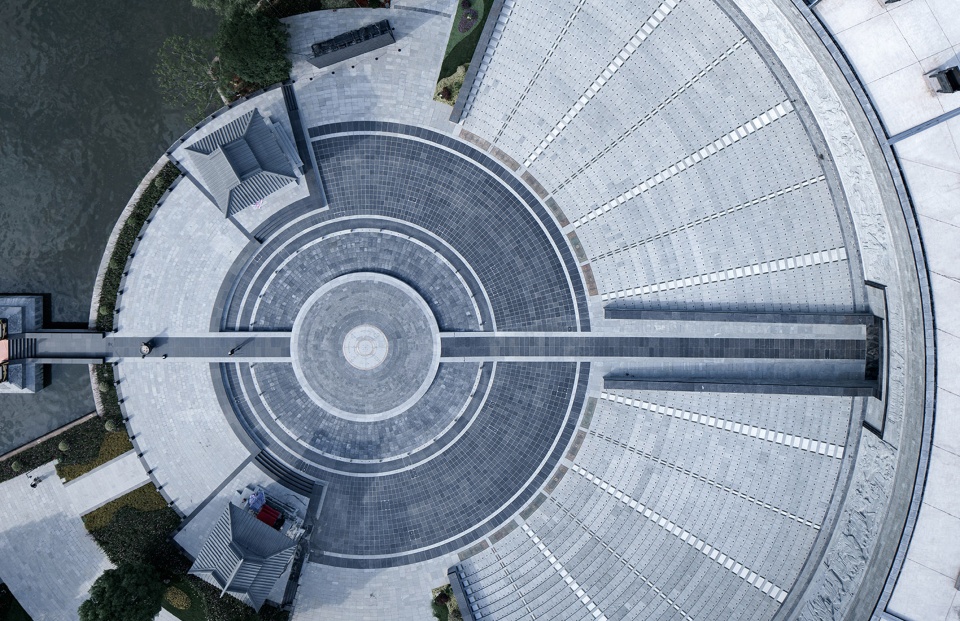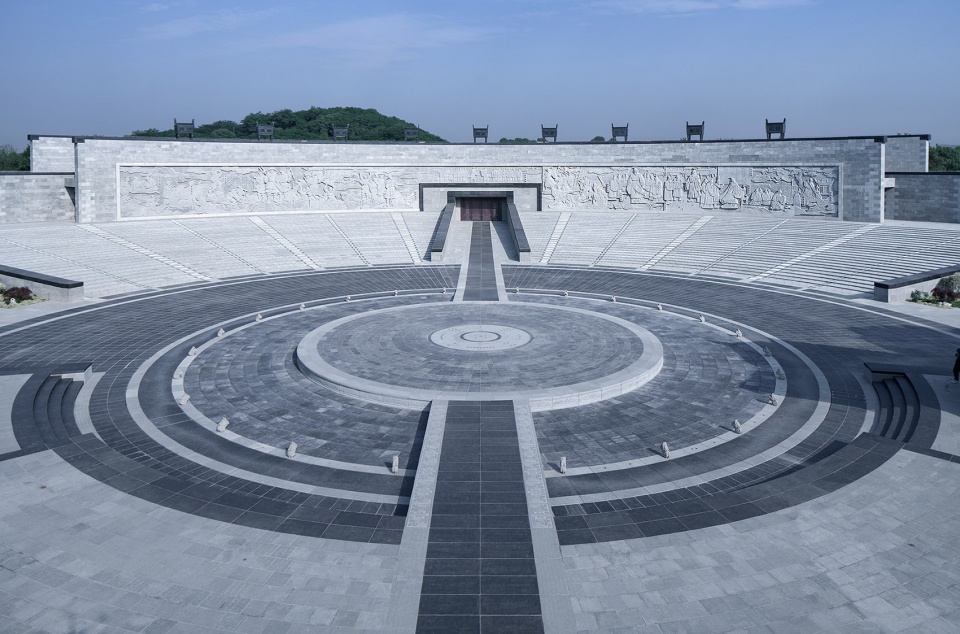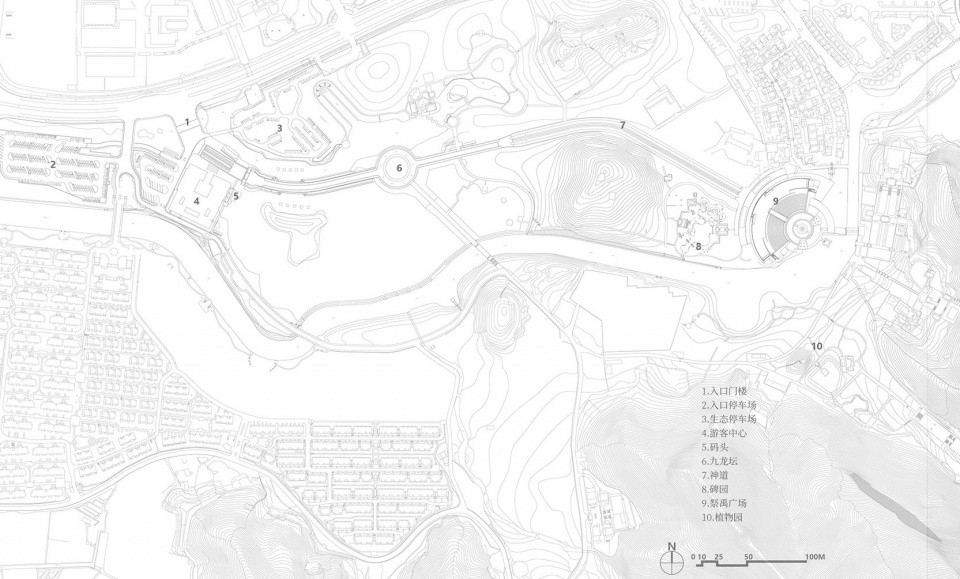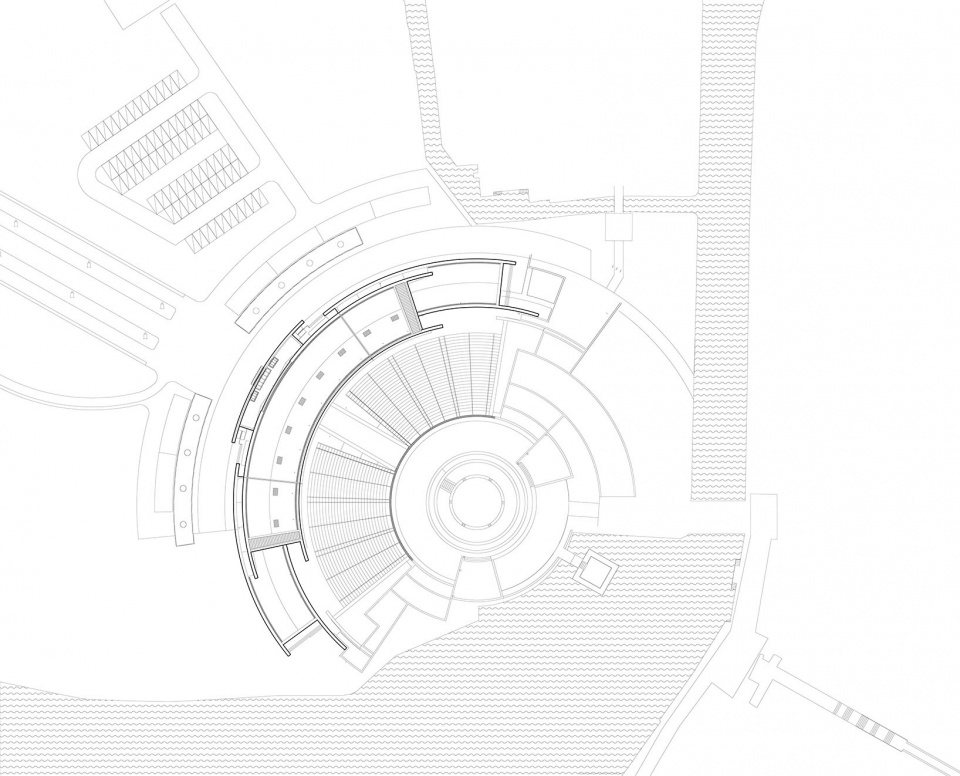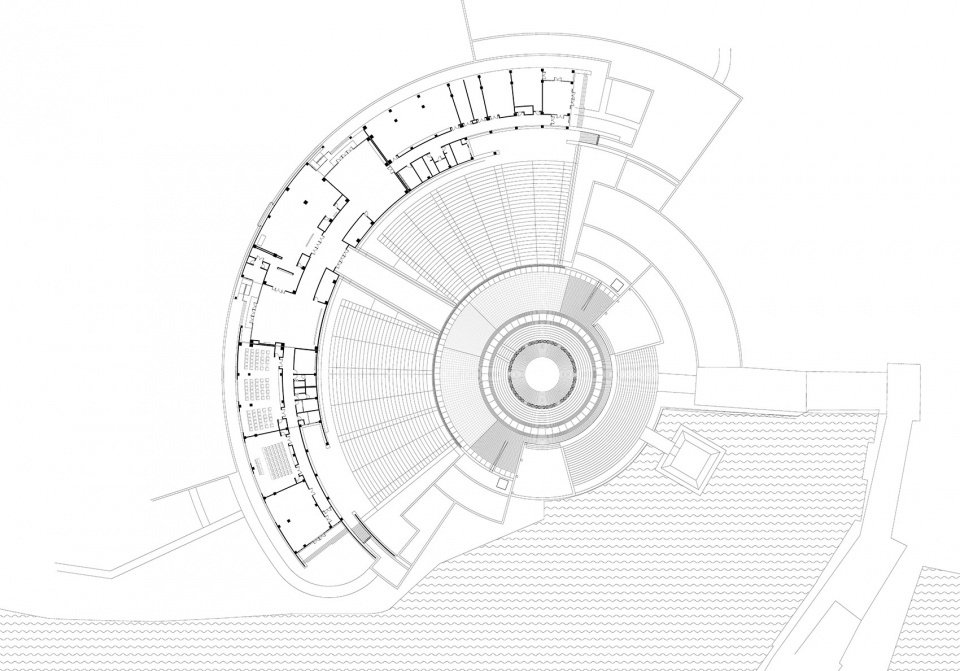绍兴大禹陵景区祭禹广场改扩建提升工程 / 浙江大学建筑设计研究院
[ad_1]
“国之大事,在祀与戎。”
“凡邑,有宗庙先君之主曰都,无曰邑,邑曰筑,都曰城。”
——《春秋左传正义》
“For a nation, the main events are sacrificial activities and military actions.”
“Any town that has an ancestral temple and past monarchs is called a ‘capital’, while that does not is called a ‘city’. And the construction of a city is called ‘walling’, while that of a capital is called ‘building’”.
——“Orthodox Exposition of the Chronicle of Zuo in the Spring and Autumn Period”
从历史上来看,祭祀活动曾经在聚落等级上的认定起着关键作用,祭祀设施也表达了古代的权力与地位。祭祀道路(涂)往往建立在一个城邑的主轴线上,周围建筑偶数对开,道路极具向心力与统领性。
Historically, sacrificial activities once played a key role in identifying settlement hierarchies, and sacrificial facilities expressed the ancient power and status. The sacrificial roads (called “Tu”) are often built on the main axis of a town, with the surrounding buildings in even pairs and the roads extremely centripetal and commanding.
▼改造后的神道与祭禹广场、山中享殿、山顶禹像在一条轴线之上,Spirit Road on the Same Axis with the Jiyu Square, the Hall of Fruition and the Great Yu Statue After Renovation © 赵强
大禹陵位于绍兴城东南六公里处的会稽山麓,占地245亩,背靠会稽山,前临禹池,风光秀美,气势宏伟。大禹是华夏立国始祖、上古治水英雄;大禹文化,更是中华文明的重要核心之一,是民族文化自信的重要支柱,为后世所景仰,各朝各代,展祭不绝。祭禹典礼自夏王启始历经4000年,世代相传,延续至今,至2007年升格为国家级祭祀活动,并定于每年谷雨时节举行。随着时代的变迁和发展,景区需要拓张新的空间以承担更多的社会责任与更大的群众期冀。
The Great Yu Mausoleum is located at the foot of Kuaiji Mountain, six kilometers southeast of Shaoxing, covering an area of 245mu, backed by Kuaiji Mountain and facing the Great Yu Pool, beautiful and majestic. Great Yu is the ancestor of the founding of China and an ancient hero of water control. The Great Yu Culture is one of the important cores of Chinese civilization and an important pillar of national cultural self-confidence, which has been admired by later ages and accompanied by endless sacrifices in various dynasties and generations. The Great Yu sacrifice rituals have been going on for 4,000 years since the beginning of the Xia Dynasty and handed down from generation to generation and continue to this day; and it was upgraded to a state-level sacrificial activity in 2007 and is scheduled to be held every year during the Grain Rain season. With changes and developments of the times, the Scenic Area needs to open up new spaces to assume more social responsibility and greater expectations of the masses.
▼从山顶大禹像俯瞰祭禹广场,A View of the Jiyu Square from the Great Yu Statue © 赵强
▼禹陵空间,The Great Yu Mausoleum Space © 赵强
▼神道尽端的祭禹馆,The Jiyu Pavilion at the End of the Spirit Road © 赵强
大禹陵景区改扩建提升工程的目标是对整个景区空间结构的梳理,景区功能的完善,进而推动大禹祭祀文化的传颂,从而让人们在自然和人文景观中更真切地感知、追忆与致敬这位华夏先祖。
The goal of the Great Yu Mausoleum Scenic Area Reconstruction, Expansion and Upgrade Project is to sort out the entire spatial structure and improve the functions of the Scenic Area, thereby promoting the eulogy of the Great Yu sacrifice culture, so that people can more truly perceive, recall and pay tribute to this Chinese ancestor in the natural and human landscape.
▼改造后的祭禹广场(从山中享殿俯瞰),The Jiyu Square After Renovation (Overlooking from the Hall of Fruition) © 赵强
▼同心片墙围合的祭禹馆,The Jiyu Pavilion Enclosed by Concentric Wallsn © 赵强
初去大禹陵便感受到大禹陵景区其作为帝陵强烈的礼仪性空间秩序性,但由于受限于之前祭禹广场的规模,神道与祭禹广场、山中享殿、山顶禹像之间的轴线成偏角关系。如何让祭禹之路的空间秩序再度强化与提升?这个思考经过多次的现场考察,并与业主的协商之后,我们提出了一个大胆而坚定的想法,将神道后半段轴线南偏,使其延续与祭禹广场、山中享殿、直至山顶的大禹像保持中正的轴线对位关系。既增强了空间秩序,又恢复了匠人营国中祭祀道路的统领性。
设计调整后的大禹陵景区的空间布局,由西向东共分为六个节点。
When first visiting the Great Yu Mausoleum, we were struck by its strong ritualistic and spatial orderliness as an emperor’s mausoleum. Restricted by the previous scale of the Jiyu Square, the axis between the spirit road and the Jiyu Square, the Hall of Fruition and the Great Yu Statue is in a deflection relationship. How can the spatial order of the Great Yu sacrificing road be strengthened and improved again? After many site investigations and consultations with the owners, we came up with a bold and firm idea to deflect the axis of the second half of the spirit road to the south so that it could continue a just axis alignment relationship with the Jiyu Square, the Hall of Fruition and the Great Yu Statue on the mountaintop, not only enhancing the spatial order but also restoring the commanding nature of the sacrificing road when artisans are building a capital.
The spatial layout of the Great Yu Mausoleum Scenic Area after design adjustment is divided into six nodes from west to east.
▼大禹陵景区一期改扩建提升工程总平面,General Plan of the Great Yu Mausoleum Scenic Area Phase I Reconstruction, Expansion and Upgrade Project © 赵强
A、景区主入口在保留原门阙的基础上重新整合形象:新建双层石质棂星门以及来源于夏朝“四阿重屋”式宫殿结构为灵感的游客中心,配置大型停车场,构成一体化入口运营服务场所。
A. The main entrance of the Scenic Area is reorganized on the basis of retaining the original gate: The new double-story stone lattice gate and the visitor center inspired by the “hip roof” palace structure in the Xia Dynasty, coupled with a large parking lot, form an integrated entrance operation service place.
▼景区入口门阙,Entrance Gate of the Scenic Area © 赵强
▼新建游客中心鸟瞰图,Aerial View Of The New Visitor Centre © 赵强
B、九龙坛进行了空间拓升:直径扩至38米、高度增至6米,加强了其外观上与景区提升后的匹配。
B. The Jiulong Altar is carried out a space expansion, with its diameter expanded to 38m and its height increased to 6m, strengthening its appearance to match the upgraded scenic area.
▼提升后的九龙坛,The Jiulong Altar After Upgrade © 赵强
C、神道后半段转向归正:为使整体布局更贴合传统帝陵形制,归正了神道中轴线,使其与洛书台、水上祭坛、大禹陵碑、山中享殿、山顶禹像处在同一轴线上,更加贴合祭祀建筑的礼制,构成了真正意义上的祭禹陵。
C. The second half of the spirit road turns to reformation: In order to make the overall layout more in line with the traditional emperor mausoleum system, the central axis of the spirit road is reformed to make it on the same axis with the Luoshu Terrace, the Water Altar, the Great Yu Mausoleum Monument, the Hall of Fruition and the Great Yu Statue, thereby being more suitable for the ritual system of sacrificial buildings and constituting a true mausoleum for worship of Great Yu.
▼归正后的神道,Spirit Road After Reformation © 赵强
D、祭禹馆西接神道,神道末端可以看到馆西立面正中处7.2米×10.9米的禹字铜碑,馆顶均布着的象征大禹功德的九鼎,以及远方的大禹神像。祭禹馆建筑通过若干同心的对称厚重弧线石墙形成一道人工屏障,围合出一片独立庄重的祭祀空间,祭禹之路的神秘感与仪式感也得以提升。祭禹馆在形式感极强的弧形墙之间,植入了更多功能,包括候祭室、排练房、休息厅和媒体发布室等。弧形墙的立面主要选用250mm厚度的高级深黑色花岗岩,石材垂直干砌而成,相较传统常用的干挂幕墙更显沉稳厚重,并利用火烧、水洗及抛光等处理手法使石材色调呈现三种深度,在色彩与质感上致敬夏朝尚黑文化。
▼改造后神道尽端的祭禹馆,The Jiyu Pavilion at the End of the Spirit Road After Reformation © 赵强
D. The Jiyu Pavilion is connected to the spirit road to the west, at the end of the latter a bronze monument of 7.2m x 10.9m with the character “Yu” is seen in the middle of the west facade of the pavilion, on the top of the pavilion there are nine uniformly distributed tripods symbolizing the merits of Great Yu, and there is a Great Yu Idol far away. The Jiyu Pavilion forms an artificial barrier through a number of concentric and symmetrical thick curved stone walls, enclosing an independent and solemn sacrificial space, which enhances the mysterious and ritual sense of the sacrifice road. The Jiyu Pavilion has more functions embedded in the curved walls with a strong sense of form, including the Waiting Room, the Rehearsal Room, the Lounge, the Media Release Room, etc. The facade of the curved wall is mainly made of high-grade dark black granite with a thickness of 250mm, and the stones are vertically laid in a dried way, being more stable and heavy compared with the traditional dry hanging curtain walls; and furthermore, the fire, washing and polishing treatment techniques are used to make the stone hues show three depths, thus paying tribute to the Xia Dynasty’s black-advocating culture in color and texture.
▼神道尽端的祭禹馆,The Jiyu Pavilion at the End of the Spirit Road © 赵强
▼神道尽端的祭禹馆,The Jiyu Pavilion at the End of the Spirit Road © 赵强
▼三种颜色深度组合的石材干砌片墙,Stone Dry Masonry Walls in the Three-Color Depth Combination © 赵强
E、祭禹广场由环形祭禹馆围合而成,游人沿神道绕过轴线末端的祭禹馆便可豁然抵达。出于帝陵风水的考量,原广场圆心及两侧的原钟鼓亭、水上祭台的位置保持不变,但将原中心的太极台改为洛书台,与大禹文化更加契合。广场半径扩大至66米,改造后的广场观演容量也将由原来的1000人扩至10000人。为了祭祀仪式时建立观演人员更舒适的视线关系,广场看台采用扇形阶梯式形制,向外升起扩散,呼应同心环形建造的祭禹馆,向心聚集下沉,形成圆形的洛书台。祭祀时主祭人员需要在祭禹馆候祭并从内侧正中的甬道走出,穿过广场中心的洛书台,经6个台阶后到达水上祭台,举行相关的祭祀仪式。
F、大禹陵碑、山中享殿、山顶禹像位于轴线的末端,均以更新保护为主。
▼绕过祭禹馆后抵达广场, Arriving at the Square After Bypassing the Jiyu Pavilion © 赵强
▼祭禹广场正立面,Facade of the Jiyu Square © 赵强
▼扇形阶梯式观演台,The Fan-shaped Stepped Viewing and Performing Platform © 赵强
▼广场地坪采用黑色砖石,致敬夏朝尚黑文化,Square Floor Made of Black Masonry to Pay Tribute to the Black-advocating Culture of Xia Dynasty © 赵强
E. The Jiyu Square is surrounded by the ring-shaped Jiyu Pavilion and accessible by visitors through bypassing the Jiyu Pavilion in the end of the axis along the spirit road. For geomantic omen of the emperor’s mausoleum, the positions of the original Bell-drum Pavilion and the Water Altar in the center of the original square and on both sides remain unchanged, but the original Tai Chi Terrace in the center is changed to Luoshu Terrace, being more in line with the Great Yu culture. The radius of the square is expanded to 66m, and the capacity for viewing and performance of the renovated square is upgraded from 1,000 persons to 10,000 persons. In order to establish a more comfortable sightlight between the spectators and the performers during sacrificial rituals, the stand is raised in a fan-shaped stepped system, rising and spreading outwards to echo the concentric ring-shaped Jiyu Pavilion, as well as centripetally concentrating and sinking to form the round Luoshu Terrace. During sacrifice, the officiant needs to wait at the Jiyu Pavilion,walk out from the channel in the middle of the inside, cross the Luoshu Terrace in the center and reach the Water Altar after 6 steps for relevant sacrificial rituals.
F. The Great Yu Mausoleum Monument, the Hall of Fruition and the Great Yu Statue are all located at the end of the axis, which should be given priority in renewal and protection.
▼祭禹广场分解图,Exploded View of the Jiyu Square © uad
▼广场圆心和鼓楼,Square Center and Drum Tower © 赵强
▼甬道,Channel © 赵强
“天美禹德,而劳其功,使百鸟还为民田”,大禹精神作为民族精神之重要渊源,彰显着中华传统文化的根与魂。祭禹广场——作为禹陵空间之精髓和历史背景下的新作,不主张随心所欲的创作,而应注重综述历史文本前提下的再写。它将兼顾文物保护与景区更新,塑造史今交错、功能复合的纪念性空间,丰富人们的空间体验,引导游人深入感受、思考并传递这一场所的精神实质,这种力量将始终被凝聚、传承与弘扬,并生生不息,源远流长。
“The contributions made by Great Yu protect farmland from flooding and bring benefits to future generations”. The Great Yu Spirit, as an important source of national spirit, manifests the roots and soul of traditional Chinese culture. The Jiyu Square, as a new work in the essence and historical context of the Great Yu Mausoleum space, does not advocate free creation but focuses on rewriting under the premise of reviewing the historical text. It will balance heritage conservation and scenic renewal, shape a monumental space with a mix of history and modernity and complex functions, enrich people’s spatial experience as well as guide visitors to deeply feel, think and convey the spiritual essence of this place. This kind of power will always be condensed, inherited and promoted, and will live on for a long time.
▼平面图,plan © uad
▼祭禹广场屋顶平面图,Roof Plan of the Jiyu Square © uad
▼祭禹广场一层平面图,Ground Floor Plan of the Jiyu Square © uad
▼祭禹馆西立面,West Facade of the Jiyu Pavilion © uad
▼祭禹广场剖面图,Section of the Jiyu Square © uad
设计方:浙江大学建筑设计研究院ACRC
项目设计 & 完成年份:2019年3月/2020年6月
主创及设计团队
主创建筑师:胡慧峰,彭荣斌
设计团队完整名单:胡慧峰,彭荣斌,章晨帆,张子权,谢锡淡
项目地址:浙江,绍兴
项目地址:3285.27平方米
摄影版权:赵强
客户:浙江省绍兴市越城区大禹陵景区
Design:The Architectural Design and Research Institute of Zhejiang University Co., Ltd.ACRC
Design year & Completion Year:2019.3/2020.6
Leader designer & Team:Hu Huifeng,Peng Rongbin,Zhang Chenfan,Zhang Ziquan,Xie Xidan
Project location:Zhejiang,Shaoxing
Gross Built Area (square meters):3285.27㎡
Photo credits:Zhao Qiang
Clients:Zhejiang,Shaoxing,Yuecheng District,Dayu Mausoleum Scenic Area
More:感谢 浙江大学建筑设计研究院有限公司。更多关于:Architectural Design and Research Institute of Zhejiang University www.zoscape.com
[ad_2]
















